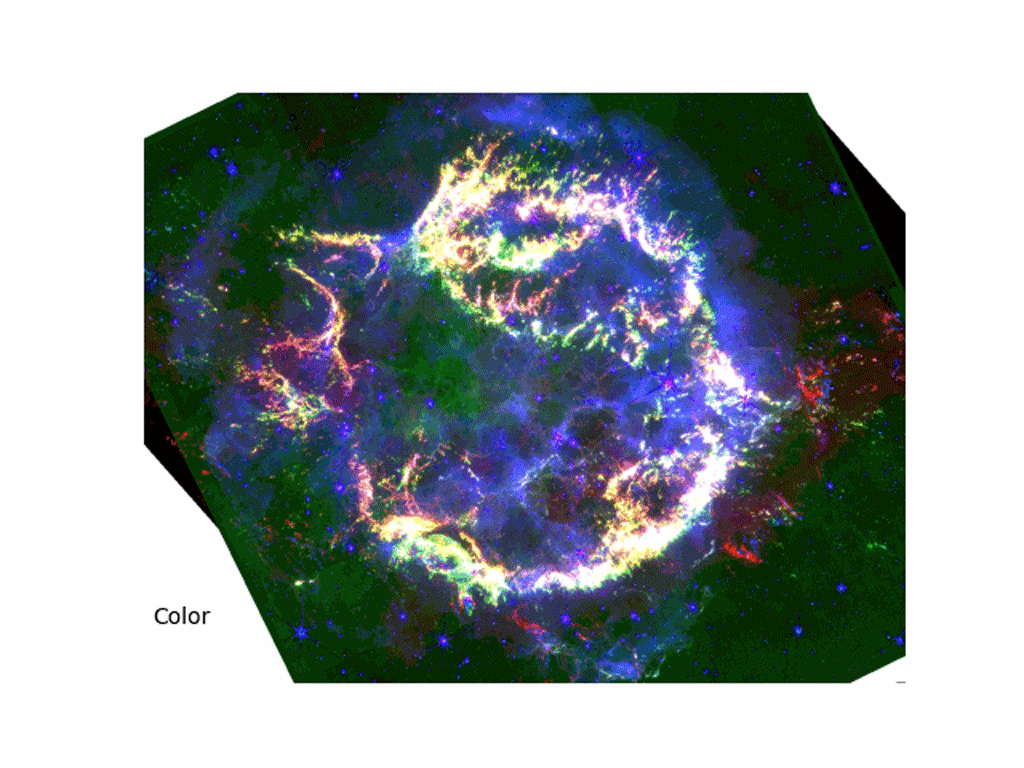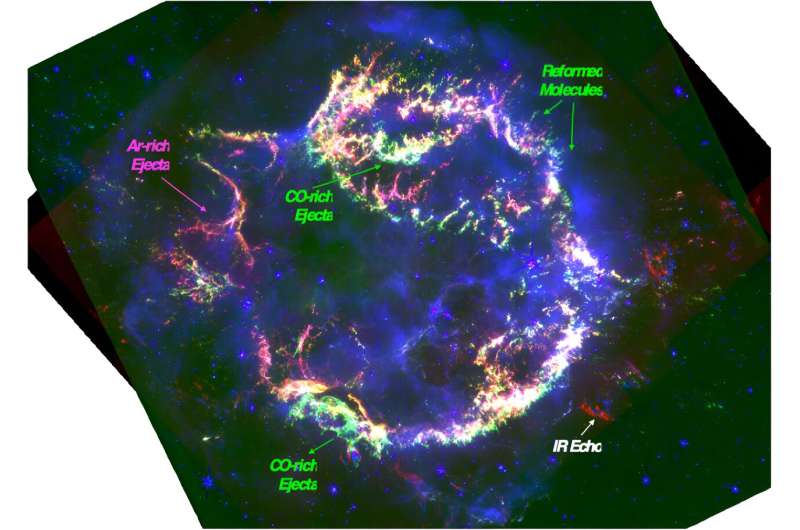Three-color JWST images of Cassiopeia A, contrasting Carbon Monoxide (CO in green) and Argon ejecta (in red) and synchrotron emission (in blue). The images show that there is more CO gas in the outer layers than argon gas, meaning that CO molecules are forming again after the reverse shock. Credit: SETI Institute
The SETI Institute announced the latest findings from the James Webb Space Telescope (JWST) of the supernova remnant, Cassiopeia A (Cas A). These observations of the youngest known core-collapse supernova in the Milky Way provide insight into the conditions that lead to the formation and destruction of molecules and dust within the supernova ejecta.
The study’s findings change our understanding of dust formation in the early universe in galaxies discovered by JWST 300 million years after the Big Bang. Researchers consider supernovae, such as those that formed Cas A, vital sources of dust seen in distant, high-redshift galaxies. These new insights challenge beliefs that dust originates primarily from intermediate-mass stars in the asymptotic giant branch (AGB) in today’s galaxies.
“It is impressive to see how bright the carbon monoxide emission is detected in JWST NIR imaging and spectroscopy, showing several tens of sinusoidal patterns of fundamental CO vibrational lines,” said Dr. Jeohghee Rho, a research scientist at the SETI Institute who led the research. . “The patterns look artificially created.”
Key findings include:
- CO molecular formation: The data show more CO gas in the outer layers than argon gas, meaning CO molecules are forming again after the reverse shock. These data are important for understanding how the cooling and formation of dust occurs after a supernova explosion. The images show that the CO molecules reformed after the impact and may have shielded the dust in the spill.
- Spectroscopy in detail: NIRSpec-IFU spectra of two important regions in Cas A show changes in how the elements formed. Both regions have strong CO gas signals and show various ionized elements such as argon, silicon, calcium and magnesium. The fundamental lines of CO are several dozen sinusoidal patterns of fundamental rovibratory lines of CO with a similar continuity from below due to the high speed of the CO molecules.
- Temperature Insights: Research indicates the temperature is around 1080 K, based on CO gas emissions. This helps us understand how dust, molecules and highly ionized gas interact in supernovae. However, the authors find vibrational lines even in the high spin lines (J=90), features that appear between 4.3-4.4 microns. These lines show the presence of the hottest temperature component (4800 K), which implies the formation and reformation of CO at the same time. CO from such high rotational levels is seen for the first time in Cas A with new JWST spectroscopy.
- Supernovae like Cas A, located 11,000 light-years away, are explosions that occur when a high-mass star comes to the end of its life about 350 years ago. Called a core-collapse supernova, the star’s interior collapses inward due to gravity once the nuclear fuel that supplied the star is depleted. The reversal of this collapse blows the star’s outer shell into space in an explosion that can outshine an entire galaxy.

Credit: SETI Institute
“Seeing such hot CO in a young supernova remnant is truly remarkable and shows that CO formation is still occurring thousands of years after the explosion,” said Chris Ashall, Assistant Professor at Virginia Tech.
“Combining such impressive data sets with previous JWST observations of supernovae will allow us to understand the path to molecules and dust formation in a way that was not possible before.”
Innovative Imaging and Spectroscopy
The observations used JWST’s Near Infrared Camera (NIRCam) and Mid-Infrared Instrument (MIRI) instruments, along with the Near Infrared Spectrograph Detailed Spectroscopy (NIRSpec)-Integral Field Units (IFU) ). The team mapped the intricate structures of the synchrotron radiation (light emitted when charged particles, such as electrons, are accelerated to high speeds in strong magnetic fields), the argon-rich ejecta and carbon monoxide (CO) molecules inside Cas A. The images show highly detailed and intricate patterns of shells, holes and filaments, highlighting just how powerful JWST is.

Credit: SETI Institute
Seong Hyun Park, a graduate student at Seoul National University in South Korea, performed the modeling of CO properties together with Rho.
The new observations highlight the complex and competing processes of molecular formation and destruction of supernova remnants. Although not directly leading to dust formation, CO molecules are critical indicators of the cooling and chemical processes that ultimately lead to dust condensation.
While this study offers new perspectives, debate continues about the extent to which supernovae contribute to the formation of dust in the early universe. Researchers will continue to explore these phenomena with future observations and research to unravel the mysteries of cosmic dust and molecular formation.
The findings were published this week in The Astrophysical Journal Letters.
More information:
J. Rho et al, Molecular characteristics of shockingly bright warm carbon monoxide in the Cassiopeia A supernova remnant detected by JWST, The Astrophysical Journal Letters (2024). DOI: 10.3847/2041-8213/ad5186
Provided by the SETI Institute
citation: Webb unveils stunning ejecta and CO structures in new supernova Cassiopeia A (2024, July 15) Retrieved July 15, 2024 from https://phys.org/news/2024-07-webb-unveils-stunning-ejecta -cassiopeia.html.
This document is subject to copyright. Except for any fair agreement for study or private research purposes, no part may be reproduced without written permission. The content is provided for informational purposes only.